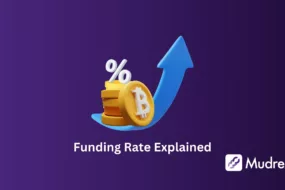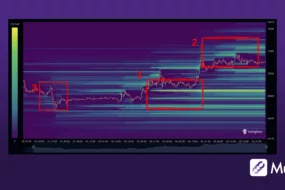
Given scalp trading’s high-frequency nature, employing effective strategies is crucial for success. These strategies help traders make quick decisions, manage risks, and optimize their chances of profiting from small price changes.
Understanding and implementing crypto scalping techniques can significantly enhance a trader’s efficiency and profitability. This article will explain the various crypto scalp trading strategies specifically tailored for the crypto market.
What is Crypto Scalping Trading?
Crypto scalping is a short-term trading strategy aimed at profiting from small price changes in the market. Traders who use this strategy, known as scalpers, execute a high number of trades over short time frames, often holding positions for just seconds or minutes. The goal is to accumulate small, consistent profits that can add up to significant gains over time.
Top Crypto Scalping Strategies
1. Range Trading
Range trading involves identifying a range within which a cryptocurrency’s price fluctuates and making trades based on these levels.
Support is a price level where buying interest is strong enough to prevent the price from falling further, while resistance is where selling pressure prevents the price from rising further. In practice, traders buy at the support level and sell at the resistance level, or short-sell at the resistance and cover the position at support.
2. Bid-Ask Spread Scalping
Bid-ask spread scalping focuses on the small differences between the bid price, the highest price a buyer is willing to pay, and the ask price, the lowest price a seller is willing to accept.
Scalpers can profit from these tiny spread fluctuations by placing buy orders at the bid price and sell orders at the ask price. To maximize efficiency, this strategy is best applied in highly liquid markets where tight spreads and quick order execution are common.
3. Momentum Trading
Momentum trading is based on trading according to the strength of recent price trends. Traders use indicators such as Moving Average Convergence Divergence (MACD) and Relative Strength Index (RSI) to identify momentum.
Entry points are chosen when these indicators show strong trends, and exit points are determined when momentum starts to wane, allowing traders to ride the wave of price movements.
4. Arbitrage
Arbitrage takes advantage of price discrepancies of the same asset on different exchanges. Traders look for these differences and execute simultaneous buy and sell orders across exchanges, profiting from the imbalance.
For instance, buying a cryptocurrency on an exchange where it is priced lower and selling it on another where it is priced higher ensures risk-free profit due to the guaranteed spread.
5. Using Moving Averages
Moving averages are another strategy that traders use to smooth out price data and identify trends over specific periods. A rising moving average indicates an uptrend, while a falling one suggests a downtrend.
Traders enter trades when the price crosses above a moving average and exit when it crosses below. Alternatively, they can use crossovers of different moving averages, such as a 50-day MA crossing above a 200-day MA, to signal buy or sell opportunities.
6. Volume Analysis
Volume analysis helps traders gauge market strength by examining the amount of cryptocurrency traded. High volume usually confirms strong trends, whereas low volume may indicate weaker trends. Volume spikes often precede significant price movements, providing lucrative trading opportunities as they signal increased interest and potential market shifts.
7. RSI (Relative Strength Index) Trading
RSI (Relative Strength Index) trading measures the speed and change of price movements, oscillating between 0 and 100. An RSI above 70 suggests overbought conditions, while an RSI below 30 indicates oversold conditions. Traders enter trades when the RSI moves out of these extremes and exit when it reaches the opposite extreme, capitalizing on price corrections.
8. MACD (Moving Average Convergence Divergence) Trading
MACD (Moving Average Convergence Divergence) trading involves a trend-following momentum indicator that shows the relationship between two moving averages. When the MACD line crosses above the signal line, it indicates a buy signal; crossing below indicates a sell signal. Traders enter positions when the MACD line crosses above the signal line and exit when it crosses below, effectively capturing momentum-driven trades.
These scalp trading strategies provide various tools and techniques for traders to exploit short-term price movements in the crypto market, each with its own set of advantages and considerations.
Essential Tools for Scalp Trading
Trading Platforms and Exchanges
Choosing the right trading platform is crucial for scalping. Look for platforms that offer low latency, high liquidity, and fast execution speeds. Popular crypto exchanges for scalp trading include Binance, Coinbase Pro, and Kraken. Ensure the platform provides advanced order types, such as stop-loss and take-profit orders, which are essential for managing trades effectively.
Technical Analysis Tools
Charts and Indicators
Detailed and customizable charts are essential for analyzing price movements. Platforms like TradingView offer comprehensive charting tools. Key indicators for scalpers include Moving Averages (MA), Relative Strength Index (RSI), and Bollinger Bands, which help identify trends, momentum, and volatility.
Volume Analysis
Volume analysis helps scalpers understand the strength of a price movement. High volume during a price increase suggests strong buying interest, while high volume during a price decrease indicates strong selling pressure. Tools like the Volume-Weighted Average Price (VWAP) can be particularly useful.
Automated Trading Bots
Automated trading bots can execute trades based on predefined criteria, making scalp trading more efficient and less time-consuming. Bots like 3Commas, CryptoHopper, and TradeSanta can be programmed to follow specific strategies, reducing the need for constant market monitoring and enabling trades to be executed at high speeds.
News and Information Sources
Staying updated with the latest news and developments in the crypto market is essential for scalpers. Market-moving news can cause rapid price changes, providing opportunities for scalping. Reliable sources include CoinDesk, CoinTelegraph, and CryptoSlate. Additionally, social media platforms like Twitter and Reddit can provide real-time updates and insights from other traders.
By leveraging these tools, scalp traders can enhance their ability to make informed decisions, execute trades swiftly, and manage risks effectively. The combination of a robust trading platform, technical analysis tools, automated bots, and up-to-date market information forms the foundation of a successful scalp trading strategy.
Best Practices for Successful Scalp Trading
Risk Management Strategies
Effective risk management is crucial for scalp trading. Setting stop-loss orders helps limit potential losses by automatically closing a position when the price reaches a predetermined level. Position sizing is another key aspect, ensuring that no single trade risks too much of the trader’s capital. By carefully managing risk, traders can protect their capital and stay in the game longer.
Maintaining Discipline and Emotional Control
Scalp trading requires quick decision-making and the ability to remain calm under pressure. Maintaining discipline and emotional control is vital to avoid impulsive decisions that can lead to significant losses. Sticking to a well-defined trading plan and avoiding overtrading are essential practices for staying focused and consistent.
Continual Learning and Adapting Strategies
The crypto market is dynamic and constantly evolving. Continual learning and adapting strategies are essential for long-term success in scalp trading. Traders should stay updated with market news, study new trading techniques, and learn from their experiences. Adapting to changing market conditions helps traders remain competitive and profitable.
Using Demo Accounts for Practice
Using demo accounts for practice is a valuable way to hone scalp trading skills without risking real money. Demo accounts allow traders to test their strategies, understand the platform’s functionalities, and gain confidence. Practicing in a simulated environment helps traders build experience and refine their techniques before transitioning to live trading.
By incorporating these best practices, scalp traders can enhance their chances of success in the highly competitive and fast-paced world of cryptocurrency trading.
Common Mistakes to Avoid in Scalp Trading
Overtrading
One of the most common mistakes in scalp trading is overtrading. Engaging in too many trades in a short period can lead to exhaustion, reduced focus, and increased transaction costs. Traders should focus on quality over quantity, ensuring each trade is based on a solid strategy rather than impulsive actions.
Ignoring Market Conditions and News
Scalp trading requires staying informed about market conditions and news. Ignoring significant market events or trends can result in poor trading decisions. Successful scalpers monitor news, economic indicators, and market sentiment to anticipate price movements and adjust their strategies accordingly.
Poor Risk Management
Neglecting proper risk management can quickly deplete a trader’s capital. Without setting stop-loss orders or managing position sizes, traders expose themselves to significant losses. Implementing robust risk management practices is essential to safeguard investments and ensure long-term profitability.
Letting Emotions Drive Trading Decisions
Emotional trading is a critical pitfall in scalp trading. Allowing fear, greed, or frustration to influence decisions can lead to rash actions and substantial losses. Maintaining discipline, following a trading plan, and staying calm under pressure is crucial for making rational, objective trading decisions.
By avoiding these common mistakes, scalpers can improve their trading performance and increase their chances of success in the fast-paced cryptocurrency market.
Conclusion
Crypto scalping offers a compelling approach to profiting from small, frequent price movements in the market. By leveraging all the strategies and practices above, traders can optimize their trading decisions. Success in scalp trading hinges on robust risk management, maintaining discipline, continual learning, and using demo accounts for practice.
By adhering to these best practices and avoiding mistakes, you can navigate the volatile crypto market effectively, maximizing your potential for consistent, incremental gains. As you begin your Trading journey, consider Mudrex your investment partner, providing accessible learning resources to guide you toward successful investments.
So, download the Mudrex app now for a successful Trading journey ahead!
FAQ Questions
What is the most profitable scalp trading strategy?
One profitable scalp trading strategy is using moving average crossovers. When a short-term moving average (e.g., 5 minutes) crosses above a longer-term one (e.g., 15 minutes), it signals a buying opportunity; a cross below signals a sell. This method allows traders to capitalize on short-term price movements, especially when combined with tight stop-loss orders and high-liquidity pairs.
How much capital is needed for effective scalp trading in India?
Effective scalp trading in India typically requires a minimum capital of ₹3,00,000 to ₹5,00,000. This amount allows traders to take significant positions, manage risks effectively, and cover transaction costs. Having higher capital provides more flexibility and better risk management, but the exact amount needed can vary based on individual trading strategies and market conditions.
Can beginners succeed in scalp trading?
Beginners can succeed in scalp trading, but it requires dedication, education, and practice. Scalping demands quick decision-making, a solid understanding of technical analysis, and effective risk management. Beginners should start with small positions, use demo accounts to practice, and continuously learn from both successes and mistakes. With patience and discipline, beginners can develop the skills needed to become successful scalpers.
How do market conditions affect scalp trading strategies?
Market conditions play a crucial role in the effectiveness of scalp trading strategies. High volatility is beneficial as it creates frequent price movements, providing numerous opportunities for quick profits. Scalping also requires high liquidity to ensure fast trade execution and minimal slippage, making liquid markets like major cryptocurrencies or popular stock indices ideal.





